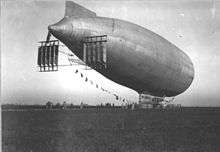List of Forlanini airships
This is a complete list of Forlanini airships designed and built by the Italian pioneer Enrico Forlanini from 1900 to 1931 (posthumously).[1] These, like the German Groß-Basenach semi-rigid airships, were the first to have the gondola attached to the envelope, to reduce air resistance.[2]

F.1 Leonardo da Vinci
- Designed: 1900-1901[3]
- Maiden flight: 2 July 1909
- Flights: 38, total distance 850 km.
- Longest duration: 90 minutes
- Length: 40 metres
- Volume: 3,265 cubic metres
- Propulsion: One Antoinette engine of 40 HP
- Maximum speed: 52 km/h
Construction started in 1900 collaboration with Cesare del Fabbro. Its first flight in 1909 was one year after the first Italian semi-rigid flight by Gaetano Arturo Crocco. Like all the Forlanini airships, except the Omnia Dir, the empennage comprised groups of multiple planes at the poop and at the tail.[2]
F.2 Città di Milano
- Maiden flight: 17 August 1913[2][4]
- Flights: 43[2]
- Length: 72 metres[1]
- Volume: 12,000 cubic metres[2]
- Gas cells: 12[2]
- Propulsion: Two Isotta Fraschini engines of 80 HP each[1]
- Maximum speed: 70 km/h[1]
- Flight ceiling: 2400 metres[2]
- Useful payload: 5 tonne[2]
- Owner: Royal Italian Army (Regio Esercito)
- Fate: 9 April 1914 emergency landing during storm, then damaged by trees and terrain while moored. While attempting to deflate gas cells, caught fire and destroyed.[1]
F.2's gondola was divided in three compartments: the command cabin, passenger cabin, and machine room. For safety all the material was treated with a fire suppressant and the envelope was double-skinned.[2]
F.3 Città di Milano II
F.5
- Built: 1917[3]
- Volume: 17,783 cubic metres[5][7]
- Length: 300 feet (91 m)[3]
- Maximum width: 66 feet (20 m)[3]
- Propulsion: Two FIAT S.76-A engines of 350 HP each[5]
- Flight ceiling: 20,000 feet (6,100 m)[3]
- Gas cells: 12[3]
- Payload: 22,000 pounds (10,000 kg)[8]
- Crew: 5: commander, two officers, two mechanics[3]
- Owner: Royal Italian Army
- Fate: military operations, decommissioned 6 February 1918
F.6
- Built: 1918
- Volume: 15,000 cubic metres[5]
- Propulsion: Four Isotta Fraschini IV-B engines of 180 HP each
- Owner: Royal Italian Army (Regio Esercito)
- Fate: one single military mission before the armistice
Omnia Dir
- Built: 1931
- Volume: 4,000 cubic metres
- Propulsion: One Isotta Fraschini of 150 HP
- Note: Used two groups of five jets of compressed air for maneuvering, one at each end
See also
- Enrico Forlanini
- Airships of Italy
- Italian military aircraft 1910-1919
Notes
- Lapini, Gian Luca
- editors of Italian wikipedia
- New York Times
- New York Times has 1912.#Tim
- Ligugnana, Sandro
- New York Times wrote F-4 appeared in 1916.#Tim
- New York Times claimed 700,000 cubic feet (20,000 m3).#Tim
- New York Times wrote payload reduces to 13,000 pounds (5,900 kg) at 7,000 feet (2,100 m) and 8,000 pounds (3,600 kg) at 13,000 feet (4,000 m).#Tim
References
- aerostati.it. Cronologia aerostatica (Italian) last accessed 2008-06-30
- Lapini, Gian Luca. 2004. Storia di Milano ::: Enrico Forlanini (Italian) last accessed 2008-06-30
- Sandro Ligugnana - Alessandro Ligugnana History - Officine Leonardo da Vinci. Last accessed 2009-09-09
- The New York Times Magazine. 13 January 1918 Page SM3. New Italian Airship Better Than Zeppelin, last accessed 2008-06-30 (full article)
- editors of Italian wikipedia article Forlanini (dirigibili) - Wikipedia